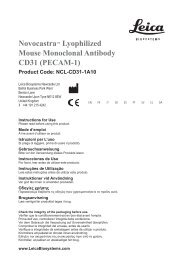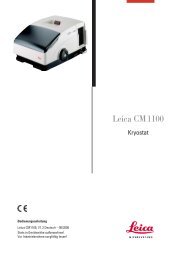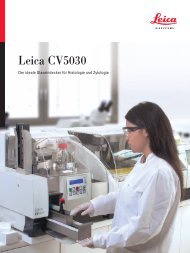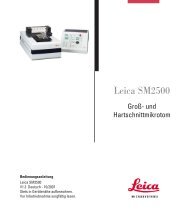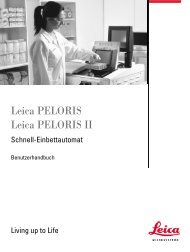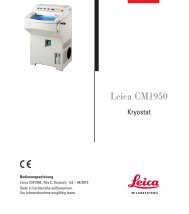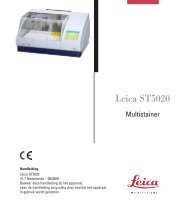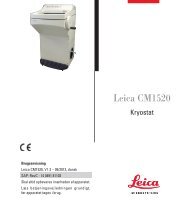Info - Leica Biosystems
Info - Leica Biosystems
Info - Leica Biosystems
You also want an ePaper? Increase the reach of your titles
YUMPU automatically turns print PDFs into web optimized ePapers that Google loves.
Novocastra TM Liquid Mouse Monoclonal Antibody<br />
Immunoglobulin M<br />
Product Code: NCL-L-IgM<br />
Intended Use<br />
For in vitro diagnostic use.<br />
NCL-L-IgM is intended for the qualitative identification by light microscopy of Immunoglobulin M molecules in paraffin sections. The<br />
clinical interpretation of any staining or its absence should be complemented by morphological studies using proper controls and should<br />
be evaluated within the context of the patient’s clinical history and other diagnostic tests by a qualified pathologist.<br />
Principle of Procedure<br />
Immunohistochemical (IHC) staining techniques allow for the visualization of antigens via the sequential application of a specific antibody<br />
to the antigen (primary antibody), a secondary antibody to the primary antibody and an enzyme complex with a chromogenic substrate<br />
with interposed washing steps. The enzymatic activation of the chromogen results in a visible reaction product at the antigen site. The<br />
specimen may then be counterstained and coverslipped. Results are interpreted using a light microscope and aid in the differential<br />
diagnosis of pathophysiological processes, which may or may not be associated with a particular antigen.<br />
Clone<br />
8H6<br />
Immunogen<br />
Prokaryotic recombinant protein corresponding to a portion of the N terminus of the heavy chain constant region.<br />
Specificity<br />
Human Immunoglobulin M molecule.<br />
Reagent Composition<br />
NCL-L-IgM is a liquid tissue culture supernatant containing 15 mM sodium azide as a preservative.<br />
Ig Class<br />
Ig2a<br />
Total Protein Concentration Total Protein<br />
1.0–8.0 g/L. Refer to vial label for lot specific total protein concentration.<br />
Antibody Concentration<br />
Greater than or equal to 41 mg/L as determined by ELISA. Refer to vial label for batch specific Ig concentration.<br />
Recommendations On Use<br />
Immunohistochemistry (see D. Methodology) on paraffin sections. Suggested dilution: 1:800 for 30 minutes at 25 o C. Heat induced<br />
epitope retrieval using Epitope Retrieval Solution pH 9.0 RE7119 or RE7122. This is provided as a guide and users should determine<br />
their own optimal working dilutions.<br />
Storage and Stability<br />
Store at 2–8 o C. Do not freeze. Return to 2–8 o C immediately after use. Do not use after expiration date indicated on the vial label.<br />
Storage conditions other than those specified above must be verified by the user.<br />
Specimen Preparation<br />
The recommended fixative is 10% neutral-buffered formalin for paraffin-embedded tissue sections.<br />
Warnings and Precautions<br />
This reagent has been prepared from the supernatant of cell culture. As it is a biological product, reasonable care should be taken when<br />
handling it.<br />
The molarity of sodium azide in this reagent is 15 mM. A Material Safety Data Sheet (MSDS) is available upon request for sodium azide.<br />
Consult federal, state or local regulations for disposal of any potentially toxic components.<br />
Specimens, before and after fixation, and all materials exposed to them, should be handled as if capable of transmitting infection and<br />
disposed of with proper precautions. 1 Never pipette reagents by mouth and avoid contacting the skin and mucous membranes with<br />
reagents and specimens. If reagents or specimens come in contact with sensitive areas, wash with copious amounts of water. Seek<br />
medical advice.<br />
Minimize microbial contamination of reagents or an increase in non-specific staining may occur.<br />
Incubation times or temperatures, other than those specified, may give erroneous results. Any such changes must be validated by the<br />
user.<br />
Quality Control<br />
Differences in tissue processing and technical procedures in the user’s laboratory may produce significant variability in results,<br />
necessitating regular performance of in-house controls in addition to the following procedures.<br />
Controls should be fresh autopsy/biopsy/surgical specimens, formalin-fixed, processed and paraffin wax-embedded as soon as possible<br />
in the same manner as the patient sample(s).<br />
NCL-L-IgM<br />
Page 2



